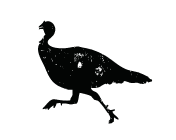Do You Hunt Gobblers in the Wet Stuff?
If you're a fisherman or waterfowler, keep those chest waders handy.
I've seen it all around turkey country. Maybe you have too. Spring gobblers favor roost trees over water — not always, surely, but trying to locate spring birds near these spots often proves favorable.
At times, all the wild turkey subspecies choose water roosts. Swamps, streams, rivers, ponds and even dry creek beds might draw them. This tendency presents some challenges to spring hunters.

River Bottom Flocks
I make my home base in Maine. There's one spring turkey location I favor a few hours after fly-down. Birds roost over the winding water — more creek than river in spots — but they're tough to hunt early. They fly down on one or the other hillsides and move off, connecting visually, and with less vocalizing than you might expect. The moving water eventually forms a swamp. They seem to like this spot year in, year out.
One year I set up on roosted gobbling birds in this spot, only to hear them fly down and shut up. I didn't push it, but instead took a nap. After months of turkey hunting around the country, I was whipped. I woke up a power sleep later, and drifted toward where I'd last heard them moving away. I set up, yelped softly and two birds gobbled back. They didn't want to come at first, so after several new setups, I got inside their comfort zone. In came a strutter and his running bud. I shot the dominant bird.
Another season I took the long walk in there a few hours after fly-down, after striking out elsewhere. On one hillside, facing another, split by the moving water, I yelped. Soon I heard footsteps running through the dry leaves toward me — down the far hillside to the bottom, where a half-dozen longbeards and shortbeards appeared. They flew-hopped the water and came right up the hill. I shot one of the longbeards after the wad of gobblers separated a bit.
Last spring on the opener I heard nothing, though I knew a number of gobblers were in there. Were they roosted over the water? No doubt. Why didn't they call? At times it's clear big groups of turkeys roosting together simply get together visually. Several hours after fly-down, with my occasional cold calling cutting through the songbird-only silence, a gobbler hammered right on top of me. I cut my eyes, saw several more and a big group of hens. They moved by, hard right. I had no shot. Dang it.
No worries though. This group had primed two other gobblers on the far hillside, above the creek. I softly yelped and both hammered back. Down the hillside they came, moving at an angle that would take them past me toward the big flock (and the sound of the original gobble).
I picked out the lead turkey and dropped it.
This Maine spot has two hillsides split by water. Turkeys linger on both hardwood side hills. They roost over water, either the creek and nearby hardwoods, or near the swamp it drains to — they favor a nearby white pine stand there, flanking the swamp. This area sees little pressure due to the long walk in and I have confidence gobblers are nearby.
Swamp Turkeys
The swamp might be skinny as a rural road, or wide and long as a football field. Either way, turkeys often fly up over such places to roost. Where they fly down is where you need to be.
Outdoor television personality and writer Tim Herald and I hunted Osceolas one spring. Herald had done the scouting. He'd found a big Florida flock roosting on the wooded shoulder of a swampy creek bed off the property. His solution was simple — the result of this Kentucky turkey hunter's well-traveled hunting experience and woodsmanship.
Brushy cover flanked the wooded roost and swampy creek. The pasture side where we could hunt had to be inviting to the flock. Scouting proved it was. On opening day, Herald sat inside a blind, decoys facing the roost but just steps from the hide, waiting with his nocked bow. The birds flew down and a handful of strutting longbeards came the whole way. It's nice when all the sight pins cover the gobbler, Herald joked back at camp.
The next day I set up on the edge of the property line, my back to the roost. Turkeys flew down, milled about. I yelped a lone sharp-spurred longbeard in as they sorted out the day's intentions.
Two longbeards in two days by two guys from the same spot. Reading the land to know the only likely dry place turkeys would fly down proved deadly. The visual of well-placed dekes closed the deal for Herald. I just made good on his scouting and hunting sense.
Flooded Timber Sits
In my experience, this might be the toughest gobbler to kill of all.
Eastern wild turkey gobblers, when alone, seem to favor this kind of roost at times. They'll find a flooded timber situation — a beaver dam or pond or whatever — and choose to roost in a tall single tree. This gives them a 360-degree fly-down option. It's almost impossible to decide where to set up on these turkeys at times. Calling doesn't always help either, since they have a great view of your spot and tend to lean toward visual evidence over turkey sounds.
I have killed a few of these birds though.
I couldn't get to the New Hampshire gobbler — he favored a single tree over a wet wooded area. So instead, I set up farther away from him than I would normally. Forget about getting inside 100 yards. I did just the opposite. My setup was three times as much, but in a bottleneck he'd have to use to get to a dry field. This required some sitting and thinking and plain old patience.
I didn't call at all as he hammered far off. No vocal hens approached his position either, best I could tell. The only thing I did is scratch leaves with my hand and wait. Well don't you know about an hour after fly-down I heard footsteps in the leaves. I'd kept my calls in my vest to avoid the urge to use them on this lookout-post bird.
The longbeard looked, seemed to listen. I yelped once with my voice and the gobbler raised his head. That was the last thing it did.
I love to call turkeys. Sometimes this actually hangs tough birds up and makes them not come. I simply opted for raking leaves with a hand to imitate turkeys feeding and sure enough this solo gobbler cruised in for a look.
Float Hunt Birds
You can also throw a canoe or kayak on your truck and navigate swollen rivers to turkeys. You can pull your trailered tin boat to a wet location. Use locator calls to contact gobblers on watery roosts.
River bottoms. Swamps. Flooded timber.
Sometimes you'll call in and kill fresh turkeys no one else has even gotten close to due to access issues.
Go here for more Realtree turkey hunting. Follow us on Facebook.
Editor's note: This Realtree.com article was first published on April 4, 2016.












































